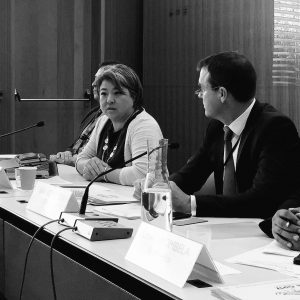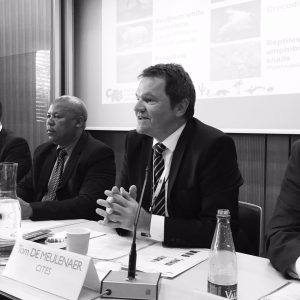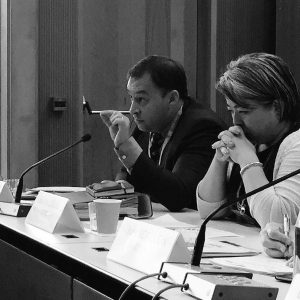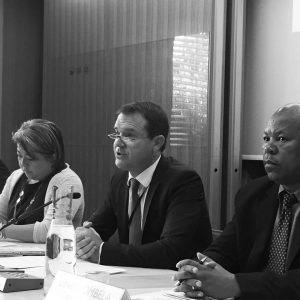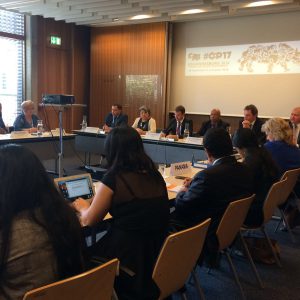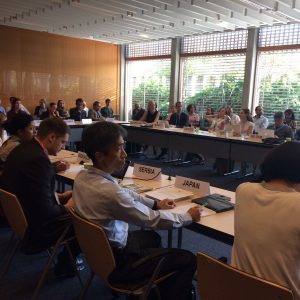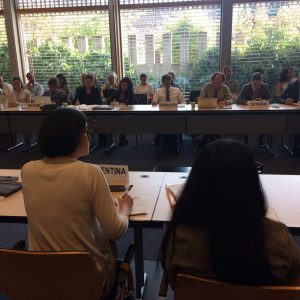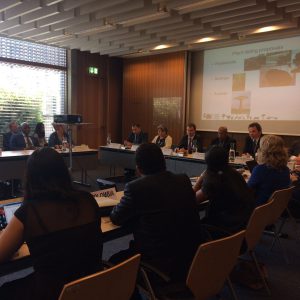Événement
Briefing on CITES CoP17
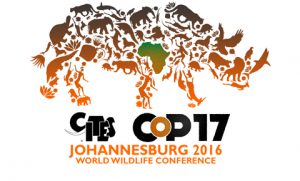
A briefing on the matters to be addressed by the 182 Parties to the Convention on International Trade in Endangered Species of Wild Fauna And Flora (CITES) at the seventeenth meeting of the Conference of the Parties (CoP17), organized within the framework of the Geneva Environment Network, took place at the International Environment House II, on Wednesday 14 September 2016. (Notification to the Parties available online)
CoP17 will take place in Johannesburg, South Africa, from 24 September to 5 October 2016. The meeting will consider 62 proposals (involving 500 species) to increase or decrease controls on international trade in wildlife animals and plants, submitted by 64 Parties from around the world. Amongst the species involved are African elephant, white rhinoceros, lion, pangolins, sharks, devil rays, as well as many species of rosewood, crocodiles, birds, frogs, lizards, turtles, and other animals and plants.
CoP17 will also take decisions concerning the CITES budget, livelihoods, traceability and sustainability of trade, combating illegal trade, including fighting corruption and cybercrime, demand reduction strategies, national laws and compliance. These will guide the work of the Parties and the Secretariat until CoP18 in 2019.
The CoP will be preceded by a high-level Ministerial Lekgotla on CITES and the SDGs, hosted by South Africa.
Agenda
10:15
Coffee & Tea
10:30
Welcome and Introduction
John SCANLON, Secretary-General, CITES Secretariat
10:45
Welcome from the host country
Lizwi NKOMBELA, Councilor, South Africa Permanent Mission to the United Nations Office at Geneva
CITES CoP17 – the big issues
10:50
Changes to the CITES Appendices and elephant discussions at CoP17
Tom DE MEULENAER, Chief, Scientific Services, CITES Secretariat
11.00
Enforcement issues – combating illegal wildlife trade
Ben Janse VAN RENSBURG, Chief, Enforcement Support, CITES Secretariat
11:10
Capacity-building and traceability of products in trade
Haruko OKUSU, Chief, Knowledge Management & Outreach, CITES Secretariat
11:20
National laws and legal issues, including CoP Rules of Procedure
Juan Carlos VASQUEZ, Chief, Legal Affairs & Compliance, CITES Secretariat
11.30
Strategic Vision of CITES, sponsored delegates, work programme and budget
Susanne BENGTSSON, Team Leader, Administrative Services, CITES Secretariat
11:40
Question-and-answer
12:00
End
Summary
John SCANLON, the Secretary-General, introduced CITES. Over the past three years the international community has rediscovered CITES and the role it can play in ensuring the survival of wildlife, as well as its potential for achieving the SDGs, the Aichi Targets and the Nagoya Protocol. There is thereof an increased need for CITES to assist countries with sustainable management of marine and forest resources.
There is one agreed objective on CITES, which is the survival of wildlife. However, different routes are taken by the parties to achieve this goal. The Johannesburg meeting will consider 62 proposals involving 500 species to increase or decrease controls on international trade in wildlife animals and plants, submitted by 64 Parties. Among these will be discussed the first resolution on wildlife climate corruption, a resolution to better engage with rural communities, a proposition by Swaziland to allow a non-lethal trade of rhinos horns and a proposition for condemning wildlife crime.
The Ambassador Nosipho MXAKATO-DISEKO from the Permanent Representative of South Africa to the United Nations Office at Geneva announced they looked forward to hosting the COP17 and hopes all parties will be able to find a consensus.
Tom DE MEULENAER, Chief of the Scientific Services explained the role of CITES science team in evaluating the 62 CoP17 proposals. Proposals were made to include, among others, all African lions, pangolins, African grey parrots, crocodiles and geckos in appendix 1. Other species such as the Peregrine falcons were suggested to be moved from appendix 1 to appendix 2. Rosewoods, the Bubinga, the Boabab, the African hardwood, Silky and Thresher sharks and Devil rays were also flagged as top priorities.
The most difficult topic will remain the discussion regarding African elephants. Currently included in appendix 1, their trade is prohibited with the four exceptions of the populations of Botswana, Namibia, South Africa and Zimbabwe. Different incompatible proposals were made such as strengthening the already existing, stopping all legal trades of ivory in the world and authorising the trade with the exception of ivory by moving all populations to appendix 2 (proposal from Namibia and Zimbabwe).
Ben Janse VAN RENSBURG, Chief of the Enforcement Support, offered explanations on enforcement issues when combating illegal wildlife trade. Since CoP16, significant steps have been taken at national, regional and international levels to combat illegal trade in wildlife:
- In July 2015, the UN General Assembly unanimously adopted a Resolution on ‘Tackling Illicit Trafficking in Wildlife’;
- In September 2015, the UN Sustainable Development Summit adopted the new global SDGs, which specifically address tackling illegal trafficking in wildlife through specific Targets under Goal 15.
- The first ever wildlife crime report was launched by UNODC, with the support of the International Consortium on Combating Wildlife Crime (ICCWC) in May 2016;
- The World Bank, on behalf of ICCWC, is finalising the development of a “Wildlife crime and anti-money-laundering” training programme, which will enhance the capacity of authorities to deploy anti money laundering investigations to combat wildlife crime;
- The ICCWC Wildlife and Forest Crime Analytic Toolkit has been implemented in 7 countries and is in progress in 12 others. It provides a framework to conduct a comprehensive analysis of national responses to wildlife and forest crime, and to identify technical assistance needs;
- The ICCWC Indicator Framework for Wildlife and Forest Crime, a self-assessment tool designed for use by countries at national level to measure and monitor the effectiveness of their law enforcement responses to wildlife and forest crime, was launched in January 2016;
- The Guidelines on Methods and Procedures of Ivory Sampling and Analysis was launched in 2014.
- The Best Practice Guide for Forensic Timber Identification was launched in 2016.
The main discussion at CoP17 will be on rhinos. Poaching in 2015 represents 5% of African rhino numbers. It is crucial for all States to remain vigilant, and continue to ensure that the measures they implement remain current and are adapted in a timely manner as may be needed to address any newly identified trends. The same tools and techniques used against other domestic and transnational organised crimes should be used against the criminal groups involved in the illegal killing of rhinoceroses and the trafficking of rhinoceros horns, and in particular against those individuals managing and organizing these illegal activities.
A special focus will also be given to the illegal trade in Asian and African pangolin species, in cheetahs and in Asian big cats. Draft decisions and resolutions will be considered.
Haruko OKUSU, the Chief of the Knowledge Management & Outreach, introduced the capacity-building and traceability of products in trade. The main issues that will be discussed at the CoP17 involve the World Wildlife Day (the 3 March); E-Permitting which involves electronic solutions for a better management, advancement in tools and systems and transaction of CITES; traceability; the implications of demand reduction; the opportunities of the legal and sustainable trade of wildlife and the capacity building initiative which involves tools to assist states to achieve better findings and get access to better technical support.
Juan Carlos VASQUEZ, the Chief of Legal Affairs & Compliance, introduced national laws and legal issues. CITES parties need to conduct an assessment on the sustainable level of trade (review of significant trade), an assessment on the legality of trade and the monitoring of the reporting of trade. The paragraph 13 of the treaty can be called when a party is accused of non-compliance. At the CoP17, the following will be discussed:
- Since the CoP16, new parties now have legislations in category 1 (Albania, Bolivia, the European Union, Mauritius, Paraguay, Moldova, Serbia and Venezuela);
- The Document 23 on compliance is currently being fine-tuned to ensure full support to the parties;
- The obligation to demonstrate the legal origin of CITES Appendix-I specimens and provide accurate information for advertised specimens may be required to account for some difficulties;
- A system to know which countries are suspended, and for which reasons, will have to be implemented;
- The national ivory action plans (NIAPs), a practical tool that is being used in a number of member States to strengthen their controls of the trade in ivory and ivory markets, will be assessed;
- The Rules of Procedure will have to be accommodated, due to the new participation of the EU.
Susanne BENGTSSON, the Team Leader of Administrative Services, offered a review of the strategic vision of CITES, adopted at the sixteenth meeting of the Conference of the Parties in Bangkok in March 2013. A revised set of indicators to ensure its implementation has lately been added. The aim is to improve the work of the convention and to ensure that international law is always taken into account.
Susanne also mentioned the 135 sponsored delegates from 102 countries. Two delegate will be working on countries with low HDI. She thanked the main founding members: Australia, Sweden, Switzerland, UK, USA, Canada, Globe Foundation, Oak Foundation…
More information and documents
Links:
- CITES #COP17 is a paperless meeting. Documents available on: https://cites.org/eng/cop/17/doc/index.php
- Guidance for submission of credentials of Parties representatives to be able to vote at CITES #CoP17: https://cites.org/sites/default/files/eng/cop/17/E-Credentials_guidance_to_CoP-16.02.16.pdf
https://www.genevaenvironmentnetwork.org/wp-content/uploads/2020/05/cop17_measures_for_species.pdf
https://www.genevaenvironmentnetwork.org/wp-content/uploads/2020/05/summary_14_september_2016.pdf

